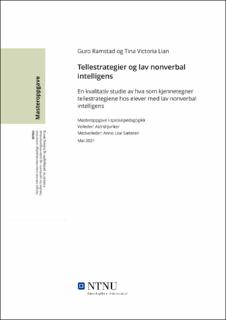| dc.contributor.advisor | Junker, Astrid | |
| dc.contributor.advisor | Sæteren, Anne-Lise | |
| dc.contributor.author | Ramstad, Guro | |
| dc.contributor.author | Lian, Tina Victoria | |
| dc.date.accessioned | 2021-09-28T17:41:49Z | |
| dc.date.available | 2021-09-28T17:41:49Z | |
| dc.date.issued | 2021 | |
| dc.identifier | no.ntnu:inspera:79273327:23768600 | |
| dc.identifier.uri | https://hdl.handle.net/11250/2784761 | |
| dc.description.abstract | Denne studien fokuserer på elevenes tallforståelse i starten av skolegangen. Målet med denne studien er å få innsikt i tellestrategiene til to elever med lav nonverbal intelligens. Vårt utvalg er valgt på grunnlag av elevenes kvalifikasjoner med utgangspunkt i klassetrinn og skårene fra den nonverbale intelligenstesten Ravens’ 2. Problemstillingen som blir belyst er følgende:
Hva kjennetegner tellestrategiene hos to elever på 1.trinn med lav nonverbal intelligens?
For å besvare problemstillingen transkriberte og analyserte vi videointervjuer av to elever på 1.trinn. Med utgangspunkt i studiens empiri og teoretiske bakgrunn ble funnene presentert gjennom kategoriene; systematisk telling og tallmønster. Disse kategoriene baserer seg på Andrews og Sayers (2015) sin definisjon av tallforståelse.
Hovedkonklusjonen i studien kan tyde på at elevene i stor grad brukte backupstrategier i stedet for retrievalstrategier i arbeidet med telleoppgaver. Elevene viste tegn til at de ikke mestret å benytte tall på en fleksibel måte. De gjennomgående trekkene i datamaterialet viste at elevene oftest brukte representasjonsformer uhensiktsmessig når de selv tok initiativ til bruk, og at voksne sin støtte og veiledning bidro til at representasjonsformene i større grad framhevet den matematiske ideen. Samtidig viste studien at det som i utgangspunktet kan tolkes som en retrievalstrategi på grunnlag av kjente tallfakta, også kan tolkes som å være en backupstrategi. At lærere er bevisst på dette og viser interesse for å kartlegge elevenes tallforståelse kan være forskjellen mellom strategirigiditet og fleksibel bruk av tall. | |
| dc.description.abstract | This thesis focuses on first grade students’ number sense. The purpose of this study is to gain insight into the counting strategies of two first grade students with low nonverbal intelligence. The students were selected based on their scores on the nonverbal intelligence test Ravens’ 2 and their school grade. The study will address the following research question:
“What are the characteristics of the counting strategies of two students with low nonverbal intelligence?”
To answer our research question, we transcribed and analyzed video interviews of said students. Based on the thesis´ empirical and theoretical background, the findings are presented through these categories: systematic counting and number patterns. These categories are based on Andrews and Sayers’ (2015) definition of number sense.
The conclusion of this study indicates that the students more often used backup strategies instead of retrieval strategies when solving the counting activities. The students also showed signs of not being able to operate flexibly with numbers. The general features of the data showed that the students mostly used forms of representation inexpediently when taking the initiative to use them. Adult support and guidance contributed to more expedient use of the representations, which further contributed to a greater extent of emphasizing the mathematical idea. The study also showed that a retrieval strategy could be interpreted as a backup strategy. Teachers being aware of this and showing interest in mapping the students’ number sense, can be the difference between the strategic rigidity and flexible use of numbers. | |
| dc.language | nob | |
| dc.publisher | NTNU | |
| dc.title | Tellestrategier og lav nonverbal intelligens | |
| dc.type | Master thesis | |
